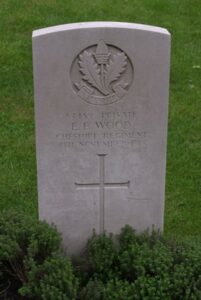Llanstadwell is a small village situated on the northern bank of the River Cleddau, in between Neyland and Milford. The men of Llanstadwell who fell during the Great War are commemorated on a brass memorial plaque, which is located inside St. Tudwal’s Church. A stained glass window inside the church is also dedicated to these men, and also to those who fought and survived. Most of these men are also commemorated on the Neyland Memorial. Photographs of the memorial were kindly sent in by Mike Berrell.
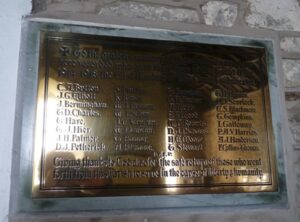
The Great War, 1914-1918
George Henry Archer, Battery Sergeant Major, 25269, Royal Garrison Artillery. George was born on 13 April 1888, the son of John Henry and Elizabeth Archer, of Gillingham, Kent. George served with the army prior to the war, and was based in Pembrokeshire prior to the war. He married Elizabeth Broad Hansford at Milford in 1913, and the couple set up home at 23, Fredrick Street, Neyland, where their daughter Ethel was born. George landed in France on 2 June 1916, with 147th Siege Battery, Royal Garrison Artillery. George fought throughout the Somme Offensive, quickly rising from Sergeant to Battery Sergeant Major. He was killed at Arras on 7 July 1917, aged 30, and is buried at Barlin Communal Cemetery Extension, France.
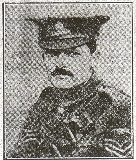
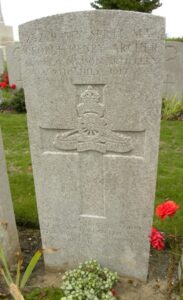
Thomas Henry Banner, MID, Sergeant, 14242, Royal Engineers. Thomas was the son of Thomas and Annie Banner, of Sea View, Llanstadwell, and had enlisted at Devonport into the Royal Engineers. He was posted to their 2nd Field Company, which was attached to the 8th Division. The 8th Division was formed during October 1914, by the bringing together of regular army units from various points around the British Empire. The Division moved to the Western Front in November 1914, a badly-needed reinforcement to the BEF which had been all but wiped out at Ypres. They saw their first major action at the Battle of Neuve Chapelle, and then at the Battle of Aubers. They then saw further fighting at the Action of Bois Grenier, before moving to the Somme in 1916, where they fought at the Battle of Albert. In March, 1917 they followed the German Retreat to the Hindenburg Line, which is probably where Thomas was Mentioned in Despatches (Gazetted on 18 May 1917). Later that year the Division moved to Ypres, fighting at the Battle of Pilckem, and the Battle of Langemarck. In March 1918 the Division were on the southern end of the Somme, and here met the German Offensive head on, at the Battle of St Quentin. They were pushed back, fighting at the Actions at the Somme Crossings, the Battle of Rosieres, and the Actions of Villers-Brettoneaux, before being withdrawn from the line to rest. However, the chosen rest area was soon to be hit by a German attack on their new positions on the Aisne, and fought at the Battle of the Aisne. Thomas was killed here on 27 May 1918. He was 38 years old, and is commemorated on the Soissons Memorial, France.
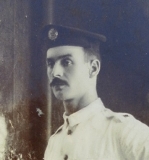
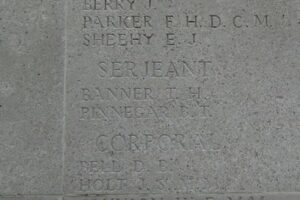
John Bryan Bermingham, Engine Room Artificer 4th Class, M/12333, Royal Navy. John was born on 14 July 1893, the son of Michael Bermingham and Annie Priscilla Bermingham (nee Morris), of 27, Kensington Road, Neyland. He worked as a fitter prior to enlisting into the Royal Navy on 2 March 1915 and after completing his training at HMS Victory II was posted aboard the Duke of Edinburgh Class Cruiser, HMS Black Prince. The Black Prince was attached to the First Cruiser Squadron during the Battle of Jutland, on 31 May 1916. She had become separated from the rest of the fleet when she was spotted by the German Battleship Thuringen, who trained her searchlights onto her, making her a sitting target for the rest of the German fleet. After a desperate 15 minute fight against the odds, the Black Prince blew apart and sank. John was 22 years old when he was killed during the loss of Black Prince. He has no known grave but the sea, so is commemorated on the Portsmouth Naval Memorial, Hampshire.
Ernest Sidney Blackmore, Private, 71225, Royal Army Medical Corps. Ernest was the son of Walter John and Agnes Blackmore, of 16, Frederick Street, Neyland. Ernest originally served with the 124th Field Company, Royal Engineers, which was attached to the 38th (Welsh) Division. He transferred to No. 1 Company, Royal Army Medical Corps in September 1915, and served on HMHS Aquitania (a Hospital Ship) from 8 October 1915 until 4 December 1915, when he was hospitalised at Alexandria, suffering from enteric fever, and spent four months recovering before being invalided to England aboard the SS Dover Castle. Ernest survived the war, bad sadly became one of the many influenza casualties which marked the end of the conflict. He died at Aldershot Isolation Hospital on 22 November 1918, aged 23, and is buried at Honeyborough Cemetery, Neyland.
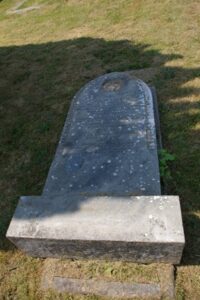
Richard James Brown, Private, 536622, London Regiment. Richard was born at Customs House, London in 1894, the son of Richard and Caroline Jane Brown. The family resided at 18, High Street, Neyland prior to the war. Richard enlisted at Cardiff into the Army and joined the 15th Battalion (Prince of Wales Own Civil Service Rifles), London Regiment, which was part of 140 Brigade, 47th (2nd London) Division. The Division moved to France during March 1915, and served on the Western Front throughout the war. The new designation of the Division, its Brigades and other constituent units changed from the 2nd London to 47th in mid May 1915. The Division fought at the Battle of Aubers, and the Battle of Festubert during May 1915 and in September fought at the Battle of Loos, and subsequent Action of Hohenzollern Redoubt. They were north of Arras when the Germans attacked Vimy Ridge, and then moved south to the Somme, where they fought at the Battle of Flers-Courcelette, and then at the Battle of Le Transloy, where the Division captured Eaucourt l’Abbe, and took part in Attacks on the Butte de Warlencourt. Early in 1917 the Division moved north to Belgium, and took part in the Battle of Messines, and then in November, 1917 fought at the Battle of Cambrai. Richard was killed at Cambrai on 6 December 1917, aged 23. Richard is commemorated on the Cambrai Memorial, Louverval, France.
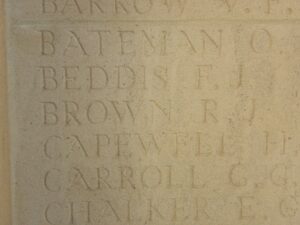
Charles Augustus Button, Second Lieutenant, Royal Field Artillery. Charles was born at Llanstadwell on 27 March 1884, the son of John and Elizabeth Button (nee Waters). By 1901 Charles is recorded as lodging at 23, Railway Terrace, Resolven, where he worked as a Railway Clerk for the GWR. At some time prior to the war, Charles had moved to London, residing at 40 Gordon Avenue, St Margaret’s (near Twickenham) in 1911, where he worked as a Bank Clerk. Here he played rugby for the local team, Rosslyn Park. Charles enlisted at Twickenham into the Honorable Artillery Company, serving as a Bombardier, service number 624077. He arrived in France on 13 March 1917, where he was commissioned Second Lieutenant into the Royal Field Artillery, and was posted to their 45th Brigade, which had been in France since 1914 attached to the 8th Division. By the beginning of 1918 Charles was a section Commander in 5th Battery, 45th Brigade, RFA, and saw heavy fighting on the Somme in March and April 1918, during the German Spring Offensive. The battered Division was then moved southwards, to the Aisne, where it was intended for it to rest and rebuild strength. However, the Germans launched a fresh offensive on the Aisne during May 1918, and Charles’ Battery were caught up in terrible fighting again, during the Battle of Bois de Buttes on 27 May 1918. Facing a numerically superior enemy force, the 8th Division suffered a large amount of casualties that day, with Charles’ 5th Battery putting up a stout resistance throughout the night until, at about 6.30am the enemy appeared on the battery position. Many guns, however, had been put out of action by direct hits before being overhauled. Charles himself was killed just after destroying important maps and documents, and was last seen lying dead in the trenches. He was awarded the French Croix-de-Guerre for his bravery, and is commemorated on the Soissons Memorial to the missing. His medals were sent to his brother M. E. Button, at 4, Great Eastern House, Neyland.
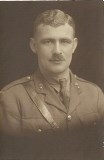
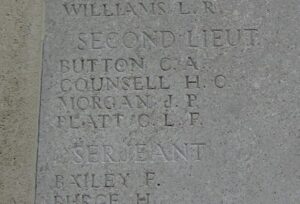
Thomas Isaac Charles, Engineman, 2716/ES, Royal Naval Reserve. Thomas was born at Neyland in 1887, the son of Thomas and Mary Charles. He was a fisherman prior to the war, and lived with his wife, Mary Ann Charles, at 8, Church Lake Terrace, Neyland. He served aboard the Trawler Dragoon, which was a 30 ton smack. On 20 August 1916 the Dragoon was captured by the German submarine UC10, who sank it by means of a bomb, about 36 miles North-East of Gromer. Thomas survived, probably being taken prisoner, but was sent home when he was taken ill, and died on 29 November 1917, aged 30. He is buried at Honeyborough Cemetery, Neyland.
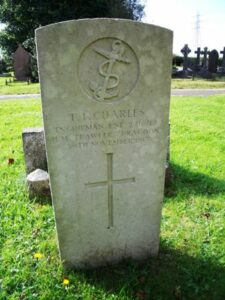
Thomas Henry Davies, Private, 60663, Welsh Regiment. Thomas was born at Jordanston Hill in 1889, the son of James and Martha Davies. He enlisted at Cardiff into the Welsh Regiment. He joined the 24th Battalion, which had been formed in 1917 by the merging of the Pembroke and Glamorgan Yeomanry, and were attached to the 231 Brigade, 74th (Yeomanry) Division. The Division had formed in Egypt in January 1917 and had fought through the Palestinian Campaign, at the Battles of Gaza and the Battle and capture of Jerusalem. Thomas was killed in action during the Third Battle of Gaza, on 27 December 1917, aged 28. He is commemorated on the Jerusalem Memorial, Israel.
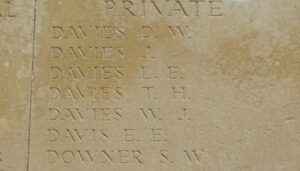
William James Edwards, Private, 91139, Machine Gun Corps. William was the son of James and Mary Edwards, of 13, Frederick Street, Neyland. He worked at Pembroke Dockyard prior to the war, and he enlisted at Pembroke on 11 December 1915 into the Army. He was posted to France on 10 August 1917, joining the 24th Company, Machine Gun Corps, which was attached to 24 Brigade, 8th Division. William saw his first action during the Battle of Langemark in August 1917. William was only at the front for two months when he was killed in action at Ypres on 27 November 1917, aged 20. He has no known grave, and is commemorated on the Tyne Cot Memorial, Belgium.
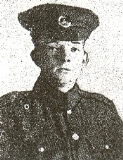
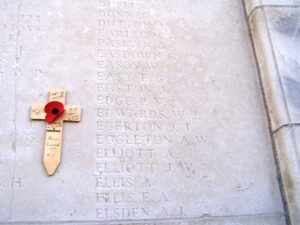
John Gilbert Elliot, Sapper, 58446, Royal Engineers. John was the son of John Henry and Annie Elliott, of Prideaux House, Hazelbeach, Neyland. He worked as a fitter prior to the war, and enlisted at Pembroke on 2 October 1914 into the 9th Welsh. He was discharged a month later as incorrigible and worthless! John re-enlisted into the Royal Engineers, and was posted to the 79th Field Company, based at the ‘E’ Training Centre. The company was attached to the 18th (Eastern) Division, which landed in Boulogne in May 1915, and didn’t see it’s first major action until July 1916 when it took part in the Battle of Albert. They then fought at the Battle of Bazentin, where they captured Trones Wood, and moved on to the Battle of Delville Wood. In October they took part in the Battle of the Ancre Heights, and captured Schwaben Redoubt, and helped capture Regina Trench. They then fought at the Battle of the Ancre, and during the subsequent Operations on the Ancre, before spending the winter on the Somme. John was wounded on the Somme and sent home for treatment, but he sadly died of his wounds on 4 February 1917, aged just 20. John is buried at Honeyborough Cemetery, Neyland.
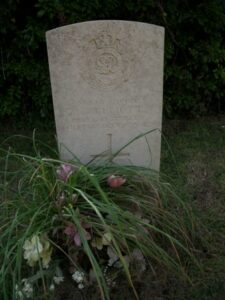
Henry James Escott, Private, 16619, Royal Irish Regiment. Henry was born in Cork, Ireland in 1899, the son of William and Emma Escott. By 1901 the family had moved to St. Davids, then by 1911 had moved again to Hazelbeach, where William was a Royal Naval Pensioner, and worked as a Writer at Pembroke Dockyard. Henry enlisted at Milford into the Army. He was posted initially to the Royal Dublin Fusiliers, but transferred to the 2nd Battalion, Royal Irish Regiment, which was attached to 188 Brigade, 63rd (Royal Naval) Division. The Division moved to France, arriving at Marseilles during May 1916 and moved to positions on the Somme, where it took part in the Battle of the Ancre, and the resulting Operations on the Ancre. In April 1917 the Division were at Arras, and fought at the Second Battle of the Scarpe, where they captured Gavrelle. They then fought at the Battle of Arleux, before moving north to Ypres, where they took part in the Second Battle of Passchendaele. Their next major action was at Cambrai, during the Action of Welch Ridge, and they were still in the area when the Germans launched their Spring Offensive, and fought at the Battle of St Quentin, and then the First Battle of Bapaume. In August, the Division took part in the Battle of Albert, which marked the beginning of the great offensive which was to end the war. They then fought at the Battle of Drocourt-Queant, and the Battle of the Canal du Nord. Henry was killed in action during the terrible fighting around the Hindenburg Line positions on 27 September 1918, aged 19. He is buried at Queant Road Cemetery, Buissy, France.
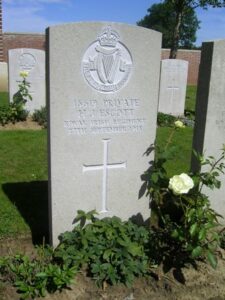
Albert Heber Evans, Private, 31413, Welsh Regiment. Albert was the son of Thomas Henry and Hester Evans, of Bungalow, Church Lakes, Neyland, and enlisted at Haverfordwest into the Welsh Regiment. He was posted to the 19th Battalion, which was the Pioneer Battalion of the 38th (Welsh) Division. The Division had landed in France during December 1915 and had spent their first winter in the trenches near Armentieres. In June they marched south to the Somme, where they were tasked with the capture of Mametz Wood. The attack on the wood began on 7 July 1916, but met with fierce resistance. The Division suffered a change in leadership before renewing the attack on 10 July, and within two days of heavy fighting, had secured the wood. The Division suffered terrible casualties at Mametz, and were taken out of the line, and moved to Ypres to rebuild. Albert was wounded at Mametz Wood, and evacuated to the Hospital at Rouen for treatment, but he sadly died there on 28 July 1916. Albert was just 19 years old, and is buried at St. Sever Cemetery, Rouen, France.
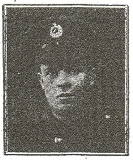
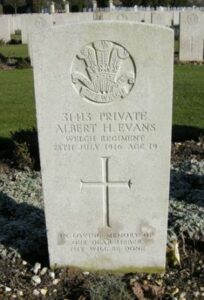
J. Galloway. This man cannot presently be identified, however a George Galloway was residing at 32, Kensington Road, Neyland and then at 48, High Street, Neyland for several years prior to the war.
Thomas George Gee, Lance Corporal, 24/1654, Northumberland Fusiliers. Thomas was born at Neyland, the son of Robert and Mary Gee. The family had moved back to their native Newcastle-on-Tyne by 1901. Thomas married in 1903, and lived with his wife, Annie Gee, at 158, Gloucester Road, Newcastle. Thomas enlisted there into the Northumberland Fusiliers, being posted to the 11th Battalion, attached to 68 Brigade, 23rd Division. Between 21 and 26 August 1915 the Division landed in Boulogne and proceeded to the Western Front, initially concentrating near Tilques. They saw their first major action at the Battle of Albert, where they captured Contalmaison, and then fought at the Battle of Bazentin, the Battle of Pozieres, the Battle of Flers-Courcelette, the Battle of Morval and the Battle of Le Transloy, where they captured Le Sars. They then moved to Ypres, which is where Thomas was killed on 5 January 1917, aged 38. He is buried at Ypres Reservoir Cemetery, Belgium.
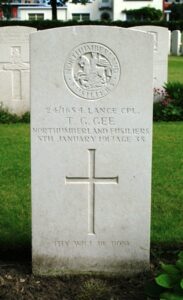
Thomas Richard Hare, Deck Hand, 691DA, Royal Naval Reserve. Thomas was born at Dover on 4 December 1877, the son of Alfred and Sarah Hare. Prior to the war he worked as a fisherman, and resided with his wife Elizabeth Hare, at 12, James Street, Neyland. Thomas worked as a Deck Hand on the trawler Amy. In August 1914 Amy was requisitioned by the War Ministry for minesweeping duties, and it was while minesweeping off Le Havre on 11 April 1917 that she struck a mine and sank with the loss of her skipper and eight ratings, including Thomas. He was 40 years old, and is commemorated on the Plymouth Naval Memorial, Devon.
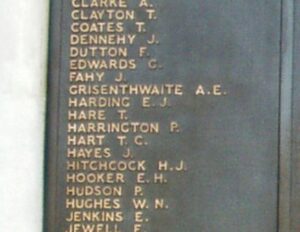
Percival Arthur Vaughan Harries, Private, 21952, Kings Shropshire Light Infantry. Percival was the son of John and Lilly Harries, of Penbryn, Hazel Bank, Neyland. He had been called up and joined the Training reserve Battalion of the Welsh Regiment, before being posted to the 1/4th Battalion, Kings Shropshire Light Infantry, which had returned from duty in Singapore, joining 56 Brigade, 19th (Western) Division in France in June 1917. The Division was by that time at Ypres, where they had taken part in the Battle of Messines. They fought on the Menin Road and at Polygon Wood, before moving up to Broodseinde, Poelcappelle and Passchendaele Village itself. In 1918 they were caught up in the German Spring Offensive near St. Quentin, where they suffered terrible casualties, and fought at the Battle of Bapaume. They moved to Ypres, but were caught up in the German attack at Messines, and at Bailleul, and Kemmel. After suffering terribly again, they moved South to the quieter French sector to rebuild, but were caught up in the German offensive on the Aisne, and fought during the Battle of the Selle, Valenciennes, the Sambre and the Passage of the Grand Honelle. Percival was wounded during the final battles of the war, and returned home for treatment. Sadly he died of his wounds in Croydon Military Hospital on 11 March 1919 aged just 20, and is buried at Honeyborough Cemetery, Neyland.
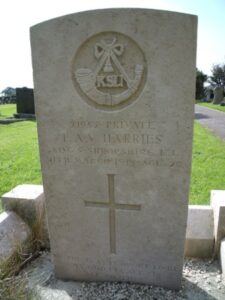
John Godfrey Wilson Victor Harris, Private, 2496, King’s Liverpool Regiment. John was born at Neyland, the son of William and Mary Harris. By 1901 the family had moved to 37, St. Domingo Grove, Liverpool. John enlisted at Liverpool on 2 September 1914 into the 5th Battalion, King’s Liverpool Regiment, which moved to France on 22 February 1915 attached to 165 Brigade, 55th (West Lancashire) Division. John was wounded within at Givenchy just weeks of moving to France, and after a brief spell in hospital rejoined his battalion at Chocques. On 24 June 1915 John was part of a fatigue party carrying out works in the trenches at Chocques. The party was returning after a hard days work when John tripped, and shot himself through the ankle. In the days before antiseptics, John’s injury became life threatening, and after having his leg amputated due to septic poisoning, he died of his wounds on 28 June 1915, aged 27. John is buried at Chocques Military Cemetery, France. John is not commemorated locally.
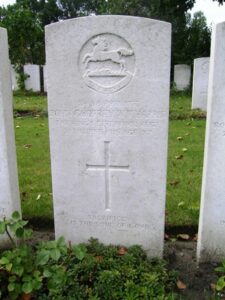
Arthur John Henderson, Engineman, 294ES, Royal Naval Reserve. Arthur was born at Steynton on 5 December 1871, the son of John and Eliza Henderson. He was a fisherman, and resided with his wife Selina, at 21, King Edward Street, Grimsby. Arthur was an engineman aboard the paddle-steamer Lady Ismay, which was a 220 foot ferry, which had sailed the Cardiff to Weston route prior to the outbreak of war. She was then requisitioned by the Admiralty, and sent to the Thames on war service as a minesweeper, but sunk near Longsand Lightship on 21 December 1915 after she struck a mine which had been laid by the German Submarine UC3. Arthur was 44 years old when he died that day, and he is commemorated on the Chatham Naval Memorial, Kent.
Thomas James Hire, Stoker 1st Class, 292159, Royal Navy. Thomas was born on 2 April 1878, the son of John and Ann Hire, of 26, Honeyboro Green, Neyland. He served throughout the war as a Stoker aboard H.M.S. Valiant, which was the smaller of the Queen Elizabeth class of Battle ships. She took part in the Battle of Jutland with all her sister ships, but escaped unharmed due in part to her superior speed. In 1916 she collided with Warspite, which put her out of action for a while, but came back into active service within a year. After the war ended she joined the Atlantic Fleet, and survived until 1947 when she was finally scrapped. Thomas served aboard her until taking ill towards the end of the war, and he died at home on 23 November 1918, aged 40. He is buried at Honeyborough Cemetery, Neyland.
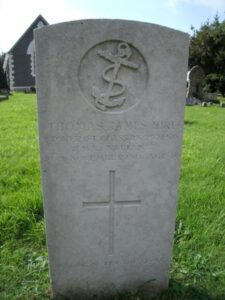
Wynford Llewellyn, Private, 4954, Pembroke Yeomanry. Wynford was born in 1898, the son of Thomas and Sarah Llewellyn, of Church Lakes, Llanstadwell. He enlisted at Haverfordwest into the Pembroke Yeomanry. The regiment formed in Tenby at the outbreak of war, joining the 1st Mounted Division. In September 1915 the front line units of the division moved to Egypt, joining the Mediterranean Expeditionary Force. The second line unit of the Pembroke Yeomanry moved to Ireland, as part of the force sent to quell the Easter Uprising. Towards the end of the Easter Risings, on 29 April 1916 Wynford was stationed near Grangegorman Hospital and had gone out with some students from the hospital to bring in some wounded civilians. He returned inside afterwards and was given a cup of tea by a nurse, before going on guard duty. Half an hour after he went back out the nurse who gave him the tea heard news that someone had been shot. He was carried into the hospital by the same students he had earlier helped and died in the arms of the nurse. Wynford was just 17 years old when he was murdered and is buried at Grangegorman Military Cemetery, in the Republic of Ireland.
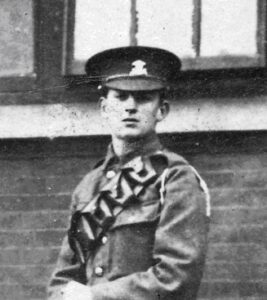
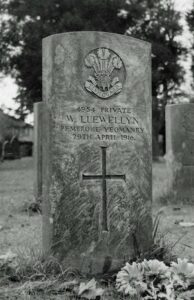
Harold Edward Moore, Private, G/118, Royal West Kent Regiment. Harold was the eldest son of Thomas E. and Elizabeth Moore, of 54, Abbott Road, Poplar, London. He enlisted at Chatham into the army and was posted to the 6th Battalion, Royal West Kent Regiment, which was attached to 37 Brigade, 12th (Eastern) Division, and landed in France in June 1915, before taking up positions near Ploegsteert. On 26 September the Division moved to Loos. Harold was wounded while his battalion was in positions near Hulloch. He died of his wounds on 3 October 1915, aged 24, and is buried at Mazingarbe Communal Cemetery, France.
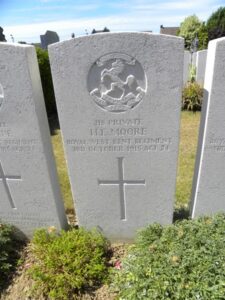
David James Nicholas, Able Seaman, Royal Navy. Little can be traced on David, but he served aboard H.M.M.L. 440, with the Royal Naval Transport Section.
James Henry Palmer, Trimmer, 2216TS, Royal Naval Reserve. James was the son of William and Margaret Palmer, of 6, West Lane, Honeyborough, Neyland, and was a fisherman prior to the war. When war broke out, the Admiralty took over the fishing fleet, and so James became a Trimmer in the Royal Naval reserve aboard the Trawler Fulmar. Fulmar was a Grimsby registered vessel, built in 1899 and taken on by the Admiralty in May, 1915. She was sunk by a mine on 17 January 1916 in the Gulf of Sollum, going down with all hands, including James. He was just 19 years old, and is commemorated on the Plymouth Naval Memorial.
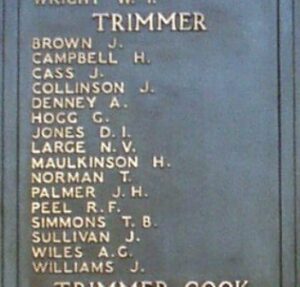
David James Petherick, Engineman, 2485TS (Dev), Mercantile Marine. David was born on 8 June 1886, the son of David James Petherick, of Briton Ferry, Neath. He served with the Royal Naval Reserve during the war, and was posted aboard HM Trawler Bradford, an anti submarine vessel. David was married to Rose Petherick, and the family had set up home at 18, James Street, Neyland. On 26 October 1916, David was at sea aboard Bradford, which was on patrol off Cork, when she sank during a storm, with the loss of all hands. David was 30 years old, and is commemorated on the Plymouth Naval Memorial, Devon. Rose passed away in 1919.
Sidney Phillips, Deck Hand, 724DA, Royal Naval Reserve. Sidney was born on 10 April 1881, the son of Ellen Phillips, of 36, Front Street, Neyland. He had played rugby for Neyland prior to the war, and had worked aboard the Irish Ship, Great Western. Upon the outbreak of war, Sidney joined the Royal Naval Reserve, and became a member of the crew of H.M. Trawler Kirkland, a trawler which had been converted for minesweeping duties. Sidney was killed when Kirkland struck a mine in the North Sea on 20 August 1917. He was 36 years old, and is commemorated on the Plymouth Naval Memorial, Devon. Sidney’s next of kin was shown as his sister, Mrs. Lavinia Jones, 32, Charles Street, Neyland.
James Ivor Rees, Rifleman, R/3412, King’s Royal Rifle Corps. James was born at Llanstadwell in 1892, the son of James and Sarah Rees. His family later moved to Goodwick at some time after 1901, and James enlisted there into the army. He was posted to the 12th Battalion, King’s Royal Rifle Corps, which was attached to 60 Brigade, 20th (Light) Division. On 22 July 1915 the battalion landed in Boulogne, and moved to the Fleurbaix Sector for trench familiarisation and training. When the Battle of Loos was launched on 25 September 1915 the Division fought a diversionary attack towards Fromelles. Later that year they moved north, and fought at the Battle of Mount Sorrel alongside the Canadian Corps. They then fought through the Somme Offensive, at the Battles of Delville Wood, Guillemont, Flers-Courcelette, Morval and Le Transloy, and took part in the advance to the Hindenburg Line in March 1917. Later that year they fought at Third Ypres, at the Battles of Langemarck, the Menin Road, and Polygon Wood, before moving south in November, to take part in the Battle of Cambrai. They remained in the area between Cambrai and St. Quentin over the winter of 1917/18 and were attacked there by the German Spring Offensive of 21 March 1918, suffering heavy casualties over the coming days. James was killed in action on 29 March 1918, aged 25. He has no known grave, and is commemorated on the Pozieres Memorial, France. James is not commemorated locally.
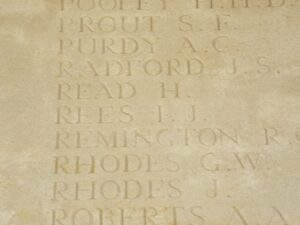
Benjamin John Richards, Carpenter Lieutenant, Royal Navy. Benjamin was the son of Thomas and Esther Richards of Neyland, and the husband of Helen Richards of 58A London Road, Portsmouth. He was an experienced sailor, having been a regular in the Royal Navy since before the Boer War, and by 1914 was a Carpenter Lieutenant aboard H.M.S. Terrible, an ancient armoured cruiser. She had seen action on the China Station, and during the Second Boer War, but was laid up afterwards, being brought back into service as a troopship at the outbreak of the Great War. Benjamin sadly died of illness at Portsmouth on 2 May 1917, aged 38. He is buried at Haslar Royal Naval Cemetery, Kent.
William George Roberts, Private, 35322, Kings Shropshire Light Infantry. William was born at Neyland on 7 September 1898, the son of Sydney and Sarah Roberts. He enlisted there into the Army, joining the Training Reserve Battalion. From there he was posted to the 7th Battalion, King’s Shropshire Light Infantry, which was attached to 76 Brigade, 3rd Division. The division had been in France since the outbreak of war, and had fought at most of the major battles that followed. In November 1917 the Division fought at the Battle of Cambrai, and they were in the area during March, 1918 when the German Spring Offensive swept through the British lines, fighting at the Battle of St Quentin and the First Battle of Bapaume. William was killed on the second day of the fighting, on 22 March 1918, aged 19. He has no known grave, and is commemorated on the Arras Memorial, France.
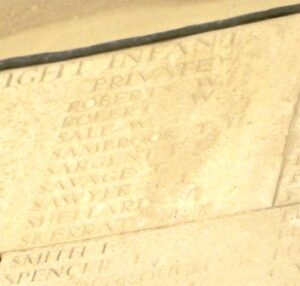
William Peter Johnson Roberts, Private, 42720, Machine Gun Corps. Peter was born at Neyland, the son of Peter and Lilian Roberts. The family later resided at 48 Rawson Road, Seaforth, Liverpool. Peter enlisted at Glasgow into the Highland Light Infantry, but later transferred into the 140th Company, Machine Gun Corps, attached to 140 Brigade, 47th (2nd London) Division. The Division moved to France during March 1915, and served on the Western Front throughout the war. The new designation of the Division, its Brigades and other constituent units changed from the 2nd London to 47th in mid May 1915. The Division fought at the Battle of Aubers, and the Battle of Festubert during May 1915 and in September fought at the Battle of Loos, and subsequent Action of Hohenzollern Redoubt. They were north of Arras when the Germans attacked Vimy Ridge, and then moved south to the Somme, where they fought at the Battle of Flers-Courcelette, and then at the Battle of Le Transloy, where the Division captured Eaucourt l’Abbe, and took part in Attacks on the Butte de Warlencourt. Early in 1917 the division moved north to Ypres, and it was here, soon after the move north, on 1 February 1917 that Peter was killed. He was just 19 years old, and is buried at Bedford House Cemetery, Belgium.

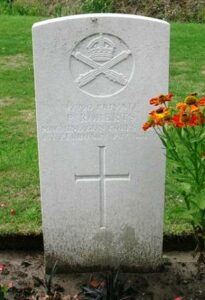
William Robinson, Private, 200343, Essex Regiment. William was born at New Milton, the son of William and Melalia Robinson. By 1911 the family had moved to 41, Parkside, Woodford Green, Essex. William enlisted at Laughton, Essex into the Essex Regiment, and was posted to the 4th Battalion, Essex Regiment. The battalion was attached to 161 Brigade, 54th (East Anglian) Division. In July 1915 the division embarked at Liverpool, for Mudros Island, and on 10 August 1915 was landed at Suvla Bay, Gallipoli. Here it remained until being evacuated in December 1915, when the entire 54th Division was withdrawn from Gallipoli, and moved to Egypt, and eventually into Palestine in early 1917. Here it fought in the successful campaign to drive the Turks from Palestine. William was killed during the First Battle of Gaza on 26 March 1917, aged 20. He is commemorated on the Jerusalem Memorial, Israel.
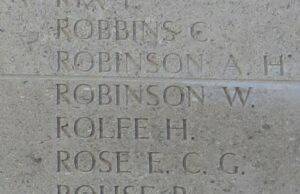
Kenneth Roy Roper, Private, PO/18905, Royal Marine Light Infantry. Kenneth was born at Dorchester on 14 September 1898, and was the son of Millie Smith (formerly Roper), of 76, Cambrian Road, Neyland. He enlisted into the Royal Marine Light Infantry on 12 September 1916, and served at HMS Colleen, the Royal Naval Depot at Queenstown in Southern Ireland. He died of pneumonia at Queenstown on 10 November 1918, aged 20. Kenneth is buried at Cobh Old Church Cemetery, the same cemetery in which many of the dead who were washed ashore after the Lusitania sinking were buried.
William James Russan, Shipwright 1st Class, 342323, Royal Navy. William was born on 8 October 1877, the son of John and Lavinia Russan. He was a pre-war regular in the Royal Navy, and had married whilst based at Queenstown, his wife Mary Ignatius Russan, residing at 11 Hawthorne Terrace, Queenstown, Co. Cork. William served aboard H.M.S. Lavender, which was a Flower Class Minesweeper, which had been launched in 1915. She was on active service when she was torpedoed and sunk in the English Channel on 5 May 1917 by UC75. William died in the sinking of the ship that day. He was 39 years old, and is commemorated on the Plymouth Naval Memorial, Devon.
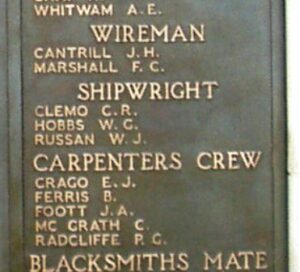
George Ernest Trevor Saunders, Sapper, 496759, Royal Engineers. George was born at Swansea in 1884, the son of Evan George Saunders and Sarah Saunders. He was the husband of Hannah Saunders, of 10a, Whiteladies Road, Clifton, Bristol. George and Hannah resided at Neyland prior to the war, and he enlisted at Neyland into the Royal Engineers, and was posted to their 457th Field Company, attached to the 62nd Division. The Division concentrated on the Western Front by 18 January 1917, and saw their first action during the Operations on the Ancre. They then followed the German Retreat to the Hindenburg Line, before taking part in the Flanking Operations Round Bullecourt, which is where George was killed on 16 April 1917, aged 32. He is buried at Villers-Faucon Communal Cemetery, France.
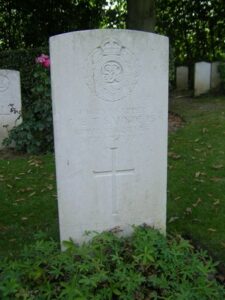
Oliver James Scurlock, Private, SE/31763, Royal Army Veterinary Corps. Oliver was the son of William Henry and Jane Scurlock, of Church Road, Hazelbeach, Neyland. Very little is known of him, but he served with the Royal Army Veterinary Corps, at No. 2 Veterinary Hospital, Longmoor. He died at Farnham, Surrey on 29 November 1918, aged just 19. Oliver is buried at Honeyborough Cemetery, Neyland. His brother William John Scurlock died in 1924 due to the effects of his wartime service, and is buried with Oliver.
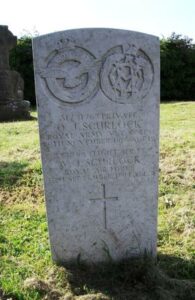
William John Scurlock, Flight Sergeant, 333064, Royal Air Force. William was the son of William Henry and Jane Scurlock, of Church Road, Hazelbeach, Neyland. He had served with the Army Veterinary Corps and the Royal Welsh Fusiliers during the Great War, and remained in the forces after the armistice, serving as a Flight Sergeant with the Royal Air Force. William died on 6 September 1924, aged 30. He is buried at Honeyborough Cemetery, Neyland. William is not commemorated locally. His brother Oliver James Scurlock died in 1918 due to effects of the war.

William John Sobey, Able Seaman, 238301, Royal Navy. William was born at Devonport on 4 December 1889, the son of William John Sobey and Matilda Marion Sobey. The family had moved to Pembroke Dock by 1901, and after William’s father’s death, moved to 11, St. Clemet’s Road, Neyland. William served as a pre-war regular aboard the Battle Cruiser H.M.S. Indefatigable. She was a powerful battlecruiser, and was attached to the 2nd Battlecruiser Squadron, under the command of Captain C. F. Sowerby. On 31 May 1916, Indefatigable became the first casualty of the Battle of Jutland, when she was hit by a salvo of 11 inch shells from S.M.S. Von der Tann. She was hit first by two shells in the “X” magazine area, blowing out her bottom and causing her to fall out of formation, sinking by the stern. Following more hits in the area of ‘A’ turret, the forward magazine exploded, and the ship sank quickly, killing all but three of her crew of 1,017. William went down with his shipmates that day. He was 26 years old, and is commemorated alongside them on the Plymouth Naval Memorial, Devon.
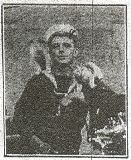
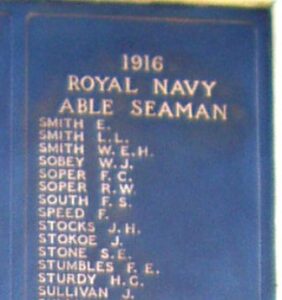
Thomas Stewart, Private, 15416, Royal Welsh Fusiliers. Thomas was the son of John and Elizabeth Stewart, of 14, Lawrenny Street, Neyland. He enlisted at Swansea into the 10th Battalion, Royal Welsh Fusiliers, which was attached to 76 Brigade, 3rd Division. One of the first Divisions to move to France, the 3rd Division remained on the Western Front throughout the war, and fought during the opening Battle of Mons, and in the epic retreat, from the Rearguard Action of Solesmes, through the Battle of Le Cateau, and down to the Marne, where the German Offensive was stopped. They followed the German withdrawal to the Hindenburg Line, where they met them in battle, and stopped the advance on Paris. The Division then moved north to Flanders, and took part in the Battle of La Bassée, and at the Battle of Messines, which were a prelude to the First Battle of Ypres. They took part in the famous Christmas Truce on 25 December 1914 and remained at Ypres throughout the winter. In 1915 the Division saw action at Bellewarde and Hooge, and took part in the Second attack on Bellewarde, and in 1916 fought at the Actions of the Bluff, and at the St Eloi Craters. Thomas was killed at Ypres on 17 February 1916, aged 24, and is commemorated on the Ypres (Menin Gate) Memorial, Belgium.
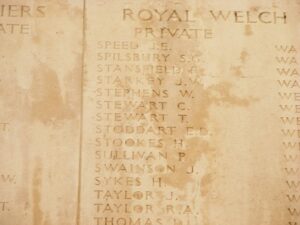
Emlyn Cyril Langham Thomas, Private, 70433, Kings Liverpool Regiment. Emlyn was the son of William and Ann Thomas, of 7, Frederick Street, Neyland. He initially served with the King’s Liverpool regiment, but after suffering from being gassed on the Western Front, he was medically downgraded, and joined the Labour Corps. Emlyn died at home as a result of being gassed, on 1 July 1921. He was 26 years old, and is buried at Honeyborough Cemetery, Neyland.
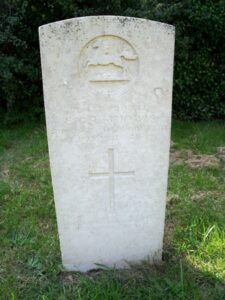
Frederick Collins Thomas, Private, 7543, Dorsetshire Regiment. Frederick was born in Middlesex in 1886, the son of William Collins Thomas and Elizabeth Jane Thomas. The family were living at 7, Grove Place, Haverfordwest by 1891, where William worked as a Solicitor’s Clerk. William worked as a Baker at Carmarthen during the time of the 1901 Census, and during 1905 enlisted as a Private with the 2nd Battalion, Dorset Regiment. By 1911 he was stationed at Wanowrie Lines, Poona, and had married a widow, Sarah Hinton, in 1910. He served with the regiment in India and Mesopotamia throughout the war, and after the armistice transferred to the 2nd Garrison Battalion, Essex Regiment, which was at Nasirabad. He remained in India after being demobilised in 1919, finding work with the Eastern Bengal State Railway, for which he had worked with as an electrician prior to enlisting in 1905. He appears to have returned to England by 1934, and died in London in 1954, aged 70. His brother George resided at Neyland, and had fruitlessly attempted to find Frederick after the war, presumably thinking him dead, hence his inclusion on the Llanstadwell memorial.
George Tomkins, Private, 54284, Welsh Regiment. George was born at Ellesmere, Salop in 1885, the son of Thomas and Sarah Tomkins. Whilst based locally with the 4th Welsh in 1916, George married Emily Louisa Folland, of 3, Church Lakes Terrace, Neyland. He was posted to the 15th Battalion, Welsh Regiment, which was the Carmarthen Pals Battalion, attached to 114 Brigade, 38th (Welsh) Division. The Division landed in France in December 1915, and was posted to the front at Fleurbaix, where it gained valuable trench experience, before marching to the Somme in June 1916, where it fought at Mametz Wood. After a mauling at Mametz, the Division was posted to a quieter sector at Boesinghe, north of Ypres, where it was to remain for the coming fourteen months. On 30 April 1917 the 15th Welsh set out on a massive raid on the German lines at the Mortjelde Estaminet, with 7 officers and 180 men. The raid was a success, but George was killed while in the German trenches, and left behind to be buried by the Germans at Manneken Farm. After the war his body was re-interred to Perth Cemetery (China Wall), Belgium. He was 21 years old.
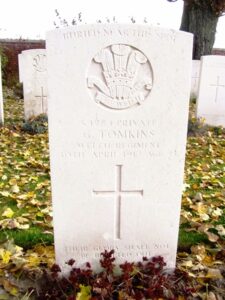
Joseph Bowen Vaughan, Able Seaman, 196437, Royal Navy. Joseph was the son of William and Mary Vaughan, of 15, Frederick Street, Neyland, and served as a regular in the Royal Navy, aboard the Minotaur Class Armoured Cruiser, H.M.S. Defence. Defence had been built at the nearby Pembroke Dockyard, and was launched in 1907. At the outbreak of war she was in the Mediterranean, and took part in the pursuit of the Goeben and Breslau. She was the flagship of Rear Admiral Sir Robert Arbuthnot at the Battle of Jutland on 31 May, 1916 when she was hit by a salvo from nearby German Battlecruisers, and blew up and sank immediately, taking with her the entire complement of 903 men. Joseph was 33 years old when he died that day, and is commemorated alongside his former ship-mates on the Plymouth Naval Memorial, Devon.
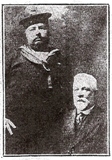
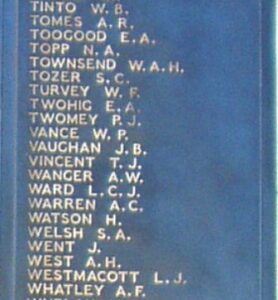
Charles Edward Warlow, Leading Carpenter’s Crew, 345941, Royal Navy. Charles was born at Angle in 1882, the son of William and Lettice Warlow. The family resided at Neyland from 1891 onwards. Charles was a regular in the Royal Navy, serving aboard the Battlecruiser H.M.S. Invincible. She was the first Battlecruiser ever built, and was launched in 1907. At the beginning of the war she took part in the Battle of Heligoland Bight, and was then sent to the South Atlantic, where she took part in the Battle of the Falklands. At the Battle of Jutland on 31 May, 1916 she was the Flagship of the 3rd Battlecruiser Squadron, where she was struck by a shell from Lutzow which penetrated her Q-Turret, igniting a flash down to the magazine, which blew her apart. Only six men out of a crew of 1,021 survived the explosion. Charles Edward Warlow was one of the dead. He was 33 years old, and is commemorated on the Portsmouth Naval Memorial, Hampshire.
Arthur Webb, Corporal, 30859, Royal Garrison Artillery. Arthur was the son of John and Eliza Webb, of Norfolk. He had served with the Norfolk Regiment, and joined the Royal Garrison Artillery in 1909. Arthur served in Pembrokeshire prior to the war with the 22nd Battery, Royal Garrison Artillery. On 27 August 1914 he was posted to the 4th Siege Battery, Royal Garrison Artillery, which moved to France in September 1914, moving to positions in Flanders, near Neuve Chapelle. Arthur was killed while his battery was providing artillery support for the Battle of Festubert on 22 May 1915, aged 29. He was originally buried on the battlefield, but after the war Arthur’s grave was exhumed, and he was buried at Vieille-Chapelle New Military Cemetery, Lacouture, France.
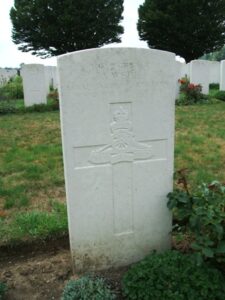
Edwin Frank Wood, Private, 67459, Cheshire Regiment. Edwin was the son of Robert and Mary Isabella Wood, of 41, Charles Street, Neyland. He had worked in the mines at Pantyffynon early in the war, and enlisted at Llandeilo into the army on 11 July 1917. Edwin served with the 62nd Training Reserve Battalion, and on 8 April 1918 was posted to the 11th Battalion, Cheshire Regiment, which was part of 75 Brigade, 25th Division. The Division had been in France since 26 September 1915. Edwin joined up with his new unit in Flanders, where it held positions at Ploegsteert, rebuilding after heavy casualties on the Somme. However, on 9 April 1918 the Germans launched an offensive on the Lys, and the Division was caught up in the terrible fighting here, at the Battles of Estaires, Bailleul, Messines and Kemmel. On 9 May the Division moved to Fismes, 20 miles SE of Soissons in the Champagne, to give it a chance to rest and rebuild again. However, on 26 May they took up positions south of the Aisne, to guard against a predicted German Offensive. On 27 May the attack hit them, and during the coming days the Division was virtually annihilated. Edwin was captured during this period, and was sent to a Prisoner of War Camp in Poland. Sadly he became ill and died there of meningitis on 4 November 1918, aged 19. Edwin is buried at Poznan Old Garrison Cemetery, Poland.
